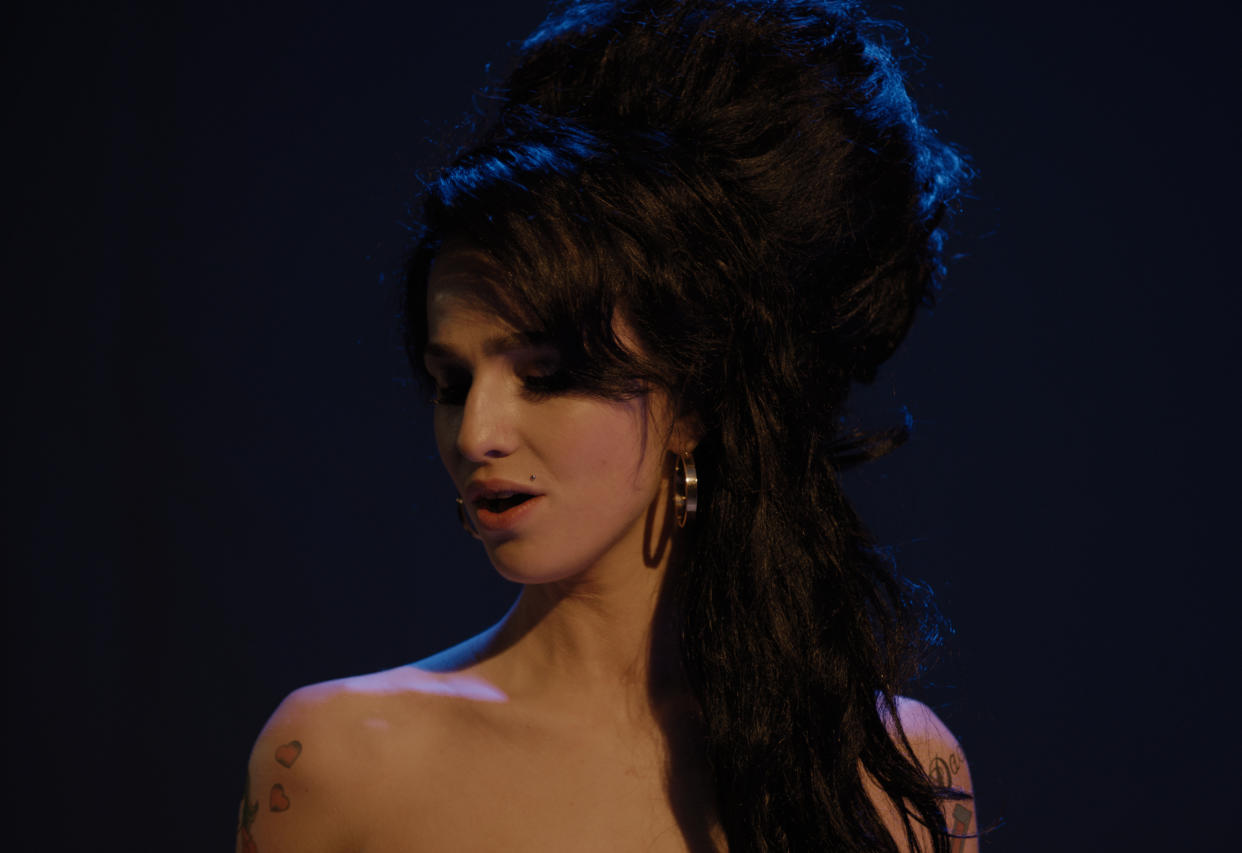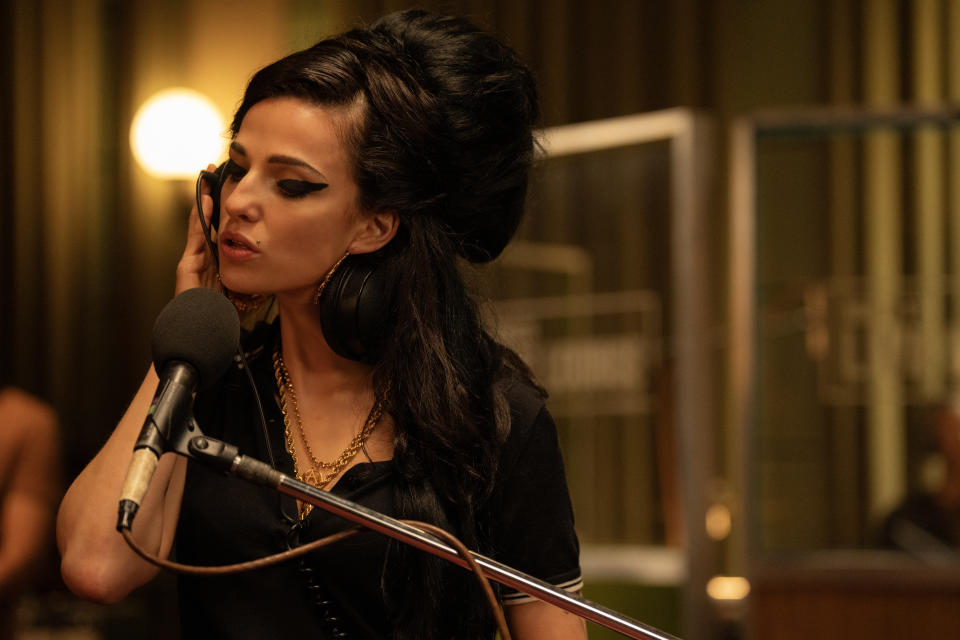‘Back to Black’ Review: Amy Winehouse Biopic Offers Crude Highlight Reel of Her Tragically Short Career

Amy Winehouse’s music endures because of her voice, obviously — that sultry Billie Holiday-esque sound that could lend timelessness to lyrics that referenced Slick Rick. Her regular producers, such as Salaam Remi and Mark Ronson, imbued her classical jazz training with a pop sound that borrowed from ’60s and ’70s soul as well as contemporary garage rock and hip hop. Her image was a knowing collage of vintage looks, but while you can’t talk about Winehouse’s hair without referencing Ronnie Spector, that amalgamation of “bad girl” styles became entirely her own. She had the unique ability to cultivate originality from a self-conscious fusion of different musical designs; any traces of influences disappeared under the weight of sampling and swagger.
The gap between Winehouse’s music and her troubled personal life was never as dichotomous as people insisted; her personal demons fueled her music, and she nurtured a refreshingly rebellious persona. However, the trajectory of her life remains undoubtedly tragic because of its familiarity: talented, vulnerable star succumbs to self-destruction exacerbated by uncontrollable fame, a parasitic media culture, and numerous bad actors disguised as allies. It’s the type of narrative that lends itself not just to tabloid fodder but also to postmortem biographies, documentaries, and now an inadequate, pre-packaged biopic.
More from IndieWire
“Back to Black” strives to be a tribute to the late singer but ends up being a dull, cherry-picked view of an already well-documented life. At best, it says nothing new. At worst, it lingers on her misfortune, albeit in the most sanitized, estate-friendly way possible. Winehouse’s short life predictably dictates the film’s plot: We watch as the artist, played by Marisa Abela, rises from her humble beginnings in small clubs to becoming a huge star beset by addiction and paparazzi. She falls in love with charming Blake Fielder-Civil (Jack O’Connell) at a pub over booze and billiards; not long after, they bond over hard drugs. Meanwhile, her father (Eddie Marsan) frets over losing his daughter to a lifestyle that’s seemingly eating her alive.
It’s understandable that screenwriter Matt Greenhalgh and editor Martin Walsh compress elements of Winehouse’s life for dramatic purposes, but so much of “Back to Black” plays like a glorified highlight reel. The film speeds through her early years so it can arrive at her relationship with Blake, which director Sam Taylor-Johnson films like a sterile mid-’00s version of Sid and Nancy. It skips over any portrayal of the recording process, a strange choice for a film named after her smash-hit record, choosing instead to focus on its inspiration, which, again, is primarily Blake. (Subsequently, it excises her numerous musical collaborators almost entirely.) Yes, “Back to Black” emphasizes her vocal talent through recreations of various musical performances, including her Glastonbury concert in 2008. But it’s more concerned with how much her headstrong attitude and emotional sensitivity created a maelstrom of despair no one could stop.

It’s not really fair that “Back to Black” operates in the shadow of the acclaimed 2015 documentary “Amy,” but so many of the biopic’s creative choices feel like desperate attempts at alibis for various implied accusations made in Asif Kapadia’s film. “Back to Black” seemingly goes out of its way to portray Mitch Winehouse as a valiant figure concerned about his daughter’s drug use from the jump (in an early scene, he lambasts her for smoking pot), which stands in sharp contrast to the archival doc’s depiction of him as a spotlight-hungry opportunist. The film also completely ignores the insidious commercial infrastructure around Winehouse that stood more to gain from her impulsivity than from protecting her health. “Back to Black” captures the unscrupulous nature of the paparazzi, but Taylor-Johnson largely treats them like wallpaper or background noise instead of an insidious force.
Casting specific blame for Amy’s downfall doesn’t necessarily lie within this film’s purview, and it’s a reasonable choice to eschew one-dimensional, villainous characterizations in favor of a more nuanced tapestry. Yet, glossing over how Blake introduced Amy to hard drugs, for example, doesn’t have to be at odds with semi-sympathetically portraying him as a young, unprincipled addict. Illustrating how a father’s concern for his famous daughter’s health might be in tension with his own financial and artistic aspirations doesn’t entirely negate any avenue of compassion. It’s one thing not to dramatize the music industry’s notorious history of enabling the addictions of stars, but it’s another entirely to constantly feature people expressing concern over Amy’s wellbeing when the truth is most people looked the other way.
The numerous omissions and timeline alterations in “Back to Black” unfortunately contribute to a portrait of a woman solely responsible for her own demise rather than a partial victim of a profit-hungry system. Moral and ethical scruples aside, it’s not impossible to make a compelling film about someone’s death drive, but Taylor-Johnson leans on so many visual clichés that “Back to Black” becomes entirely unmemorable. Multiple scenes are peppered with blurred edges or faint double vision to illustrate intoxication. The film can’t get enough of Amy stumbling or running down a London street, sometimes in the rain with bottle in hand or alongside noxious photographers. (The only time “Back to Black” exhibits a sly sense of humor is when Blake offers Amy crack cocaine in a diamond ring box over a fast food dinner in their swanky hotel room following their wedding.) Taylor-Johnson frequently returns to the image of a caged bird throughout the film in case audiences forget the central groan-inducing metaphor. Aside from the very beginning, it’s rare that Taylor-Johnson depicts Amy as anything but an inevitable tragedy, something that the borderline-tasteless ending all but underlines.
The only scenes where Amy comes alive are when she first meets Blake — a genuinely strong dirtbag meet-cute, even as it claims that Winehouse had never heard of The Shangri-Las prior to meeting her future husband — and whenever she performs on stage. Abela was subject to scrutiny regarding her performance ahead of the film’s release, especially considering that she performs all of Winehouse’s songs herself. While she overdoes her North London accent and relies upon exaggerated facial expressions to convey Winehouse’s snarling, provocative manner, Abela ultimately offers a solid imitation of the singer, one that becomes more relaxed as the film continues. But no matter how intermittently lively Abela’s performance can be, it can’t transcend its secondhand nature. Similarly, the recreated live performances, while occasionally compelling, will mostly just remind people of the real article. You don’t really need to see a dramatized version of Amy’s Grammys acceptance speech when the actual footage is readily circulated.
The palpable sincerity behind “Back to Black” almost makes its myriad weaknesses more glaring. Everyone involved in the film approaches the late artist with love and respect, but its tawdry instincts and misguided sense of responsibility let her memory down. Its refusal to delve into the ugly realities of addiction or pop stardom generates a vague portrait of a lost girl in need of saving. Music, as the film version of Amy says, was Winehouse’s rehab, but in “Back to Black,” it’s basically an afterthought.
Grade: C-
Focus Features’ “Back to Black” opens in the U.K. on Friday, April 12. The film will open in the U.S. on Friday, May 17.
Best of IndieWire
Sign up for Indiewire's Newsletter. For the latest news, follow us on Facebook, Twitter, and Instagram.
